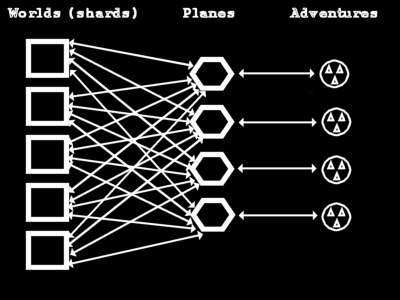This is a comment I posted on Chris blog about the role of artifacts in MMOs:
“How can developers reconcile the rarity (or uniqueness) of an artifact with the desire of players to own it?”
My answer starts in the specifics but then opens up to criticize the current solutions in other game and explain some more my idea behind the “dream mmorpg” that I keep shaping up from time to time. It’s another recurring topic in mmorpg design and another of those with the most awful answers till now. So worth looking at to see if there’s a space to improve and bring something new to the table.
I guess I should rewrite it to pull a better and more complete and readable analysis, examining all the different cases to see where they worked and where they didn’t to conclude with general considerations about the viable, better paths that could be available. But that would require time and commitment. But right now I find harder and harder to even put two lines of text together and even if I managed to do that I’ll just finish a comment too long that noone will be interested to read. So the comment will remain a rough shape of the same ideas.
—
Is this coming from our discussion or you are just gathering ideas freely?
Of course this interests me since it’s one of the systems I was tinkering with. The design questions you made at the origin are the same, but I found different answers in order to adhere better to the rest of my plan.
Some of your ideas sound rather interesting even if I see some problems here and there that won’t be that easy to solve. For example it would be rather hard to even code the pathing in the right way in order for the guardian spirit to chase the players along all the world and with his minions. Considering all the problems WoW is having right now with the train of mobs (like Lord Kazzak invading Stormwind) I also fear that the whole mechanic could become more fun as a creative exploit than for the actual use of the item. And, of course, this doesn’t look nice.
I personally don’t love too much the idea of countdowns and “at loss” situations. This directly aims for the pure catassers that will have the guild support to gain and keep up the artifacts and its “requirements/side effects”. And this isn’t really appealing as it should be.
So what I don’t like is the actual mechanic of the guardian chasing the player and the negative, progressive side effects. But you also suggested me new elements that could be fun to develop and expand.
My own idea remains connected the “design” purpose of an artifact (not the “lore”, just the design pattern):
– A rare, special item to offer a substantial (unbalanced) power up that shouldn’t become a direct requirement.
In a PvE environment this type of tool could be a “key” to solve a particular puzzle (like the special magic item that can slay a particular mob), but it’s in PvP that the design comes to the surface as an unbalanced power. As I commented in our discussion I think that the unbalance is an interesting mechanic, in particular in PvP (another of my heresies). This is why it should be used instead of feared and this is also why my answers to your questions pivot around the PvP.
Artifacts are unique -> they can be gained through instanced PvE but they have no effect till they are pulled out to the persistent world (where PvP happens). Once this passage is complete only “x” number of artifacts can exist. In the persistent world they become persistent items. Let’s say that they “solidify”. They are unique or rare based on the type.
Note: The artifacts cannot be used to access other instanced PvE content since the artifacts banish the player from the access of portals. So they are exclusively PvP tools and this because of another design reason. In PvE an overpowering tool just begs to become an exploit tool and will be used directly to bypass the difficulty that the devs have planned for a specific encounter. I believe that overpowering tools in PvE do not offer anything that is fun or interesting, they just become pattern-breaking tool, hence they should be put aside.
Artifacts are powerful -> They are. They are directly planned to transform a player (along with bonuses for allies) as a “raid encounter” himself. Veguely reminding the old ideas of players playing as mobs. In a 3D graphical game the wielder of an artifact will become a demon, graphically. The size will increase, it will use different powers, attributes and so on. The player with an artifact becomes “content” for the players of the opposite faction. A goal. A target. (I explain later the actual “reward” the encounter represents)
Since the artifacts cannot be traded or dropped and since they banish the player from accessing the PvE instances, the player won’t be able to get another artifact. So the problem of stacking these tools is solved at the root without developing specific systems.
The important point, though, is nested in your first question: “artifacts need to have a mechanism to regularly leave the characterâ

